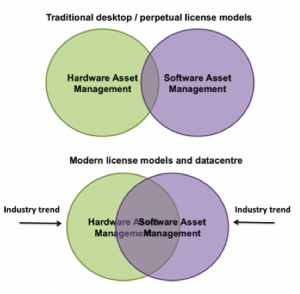The convergence of SAM and HAM
 This is part two of a two-part series on environment recognition. See part one here: ‘Modern SAM requires ‘Environment Recognition’ as much as ‘Software Recognition’.
This is part two of a two-part series on environment recognition. See part one here: ‘Modern SAM requires ‘Environment Recognition’ as much as ‘Software Recognition’.
In my last article I explored the concept of ‘environment recognition’. I suggested that modern Software Asset Management (SAM) is not just about recognizing software in your estate and counting installs, but also understanding the environment in which it is used. In this article I will explore some real life examples of license models that require environment recognition.
There is a convergence in the industry between software, hardware and configuration detail in license models. You could argue that this is mainly due to Moore’s law and the logarithmic growth in processing power and virtualization technologies in datacentres.
Software publishers can maximize license revenue by aligning themselves to this growth in computing power. If software publishers were only charging for their software based on installs they would be missing out on significant leaps forward in innovation and value from the software.
The convergence between SAM and Hardware Asset Management (HAM) has serious impact to how we measure compliance, usage and value and is causing many organizations to revisit their entire SAM strategy.
Environment Recognition Examples
The following license models are examples of high value software that requires much more than simply counting the number of installs in order to verify compliance:
- Microsoft SQL Server– Simply counting the number of installations of Microsoft SQL Server is not good enough. Microsoft SQL Licensing might require that you identify memory used, processors and cores of the physical device, virtualization strategy, failover and test strategy, business use of the server (e.g. Production, Test, Failover etc.) and enterprise use or connectivity e.g. Client Access consumption.
- Autodesk, Adobe, and Office 365 – Autodesk and Adobe have been pushing their clients towards user centric subscription models rather than per traditional per installation models. Similarly Microsoft Office365 licensing entitles usage of software and services across multiple devices – license compliance is based on users and the relationship between devices rather than simply licensing the existence of software. Microsoft recently stated ‘around 80% of organisations are making the shift from device to user centric agreements when renewing’
- Oracle, IBM – Oracle database licensing is based on the underlying hardware of the database, what it might possibly use in terms of processing power and how the database is configured. Similarly IBM licensing in the datacentre is based on the underlying hardware profile of devices and processing capacity rather than simple existence of software.
https://twitter.com/itammartin/status/476321649927929856
At ITAMS, we recommend to clients that a SKU Catalogue underpin their SAM strategy.
A SKU catalogue allows organizations to build a verified system of record to capture all of the environmental conditions required to measure compliance, usage and maximize value from software investments…. No matter how many inventory and procurement sources the Asset Manager may be juggling with!

Your points about the difference between SAM and HAM are well made, especially when it comes to enterprise software from Microsoft and Oracle.
The license metrics are no longer simply what version or edition is installed.
You could consider a 3rd element to Asset Management, Mobility.
Be it in the data centre where servers and applications can move from server to server, the cloud or where users are using several devices.
I think differentiating between SAM / HAM will disappear. The question is when will ITAM also disappear and we simply talk about ITRM, resource management, not caring where it’s hosted, if it’s a service, or on what device, only how much of the service we are consuming
During the most recent IAITAM conference in Las Vegas, this topic was thoroughly discussed.
Most mid size to large size companies are truing up software audits with physical inventories and working to reconcile the difference between the known assets with software versus the unknown assets with software.
Typically, only 80% of the software assets are captured online, thus the convergence of HAM with SAM, you cant have one without the other.
If your consulting vendor is not mentioning this as part of the holistic approach, you should challenge the concept with another partner.